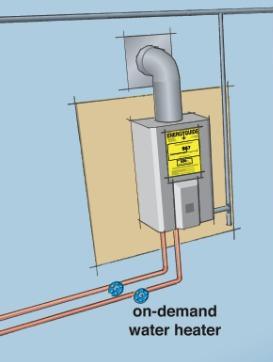What this tool does

This “solve-all” tool is used for sizing an instantaneous (tankless) hot water heater. It can also be used to determine the maximum hot water flow rate for a given system and temperature rise.
Calculated values
- Temperature rise – the difference between the temperature of the cold water entering the water heater and the heated water leaving the appliance.
- Peak flow rate – the design hot water flow rate.
- Input heat value – the required instantaneous energy input rate. Use this value to select an appropriately sized unit.
Tips
- Clicking the label for any input or result will cause a popup help box to appear. This help box includes the allowed and normal values (for inputs).
- This is a “solve-all” tool. Select the radio button to the left of the label for which you wish to solve. This label will turn to blue and the input box will disappear.
- Some instantaneous (demand) water heaters have a fixed output, which increased the water temperature by a fixed number of degrees for a given flow rate. Others have a variable output (firing rate) that increases as the flow rate increases. It is important to know the characteristics of the appliance before sizing.
- Recovery efficiency – the rated recovery efficiency of the water heater. Enter as a percent; 78 instead of 0.78. For most water heaters, standby losses are minimal so that the recovery efficiency is essentially the same as the energy factor (EF). A case in which these efficiency values are substantially different would be a tankless coil in a boiler, where standby losses in the summer are a large fraction of the total energy input. In that case, the steady-state efficiency (SSE) is likely to be a good approximation of the recovery efficiency.
Background
Because this is a “solve-all” tool, each of the values below will be treated as inputs unless selected as your result using the radio button to the left of the label.
- Temperature rise – the difference between the temperature of the cold water entering the water heater and the heated water leaving the appliance.
- Peak flow rate – the design hot water flow rate. See Table 1, below, for flow rates for mixed (hot + cold) water uses. Use the DHW Volume per Use tool to determine the hot-water-use portion of this flow.
- Input heat value – the required instantaneous energy input rate. Use this value to select an appropriately sized unit.
| Water Use | Flow Rate, Mixed - Gpm (Lpm) |
|---|---|
| Hand-washing sinks | 0.2 to 1.0 (0.8 to 3.8) |
| Showers | 0.8 to 2.5 (3.0 to 9.5) |
| Bathtub fill rates | 1.0 to 6.0 (3.8 to 22.7) |
| Dishwasher fill rates | 1.0 to 3.0 (3.8 to 11.4) |
| Clothes-washing machine fill rates | 1.0 to 6.0 (3.8 to 22.7) |
| Residential whole-house recurring peak rates | 3.0 to 4.0 (11.4 to 15.1) |
| Residential whole-house severe-peak rates | 6.0 to 8.0 (22.7 to 30.3) |
| Table data from ASHAE Handbook of Fundamentals. | |
Best Practices
Select a water heater that has an input heat rate that is equal to or greater than the “Input heat rate” tool result.